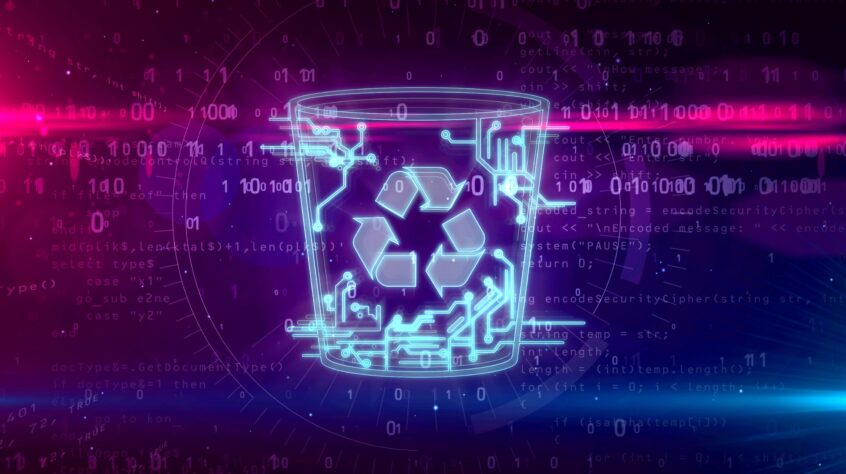Digital Pollution
Digital pollution has become one of the largest negative contributors impacting our environment globally. According to Global E-waste Monitor 2020, more than 53 million metric tons of electronic waste was produced in 2019. This amount of waste equates to more than the total number of commercial aircraft manufactured. EVER. Used enterprise assets such as computers, servers, hard drives, mobile phones and more make up a large portion of this amount.
For years, consumers have become more environmentally conscious of their impact on the environment through their use of energy and water consumption and have taken efforts to reduce their carbon footprints. In the business sector, sustainability has become paramount for corporations of all sizes. In fact, many organizations have created initiatives to influence social change through corporate social responsibility (CSR) best practices. Additionally, environmental, social and governance (ESG) issues are becoming even more relevant to investors and key stakeholders as they evaluate an organization’s performance and risk.
IT Industry Tends to be Wasteful
Specifically, there are concerns regarding the energy efficiency of data centers, with one researcher forecasting the storage of digital data will account for 14% of the world’s emissions by 2040. Coupled with the acceleration of cloud adoption as enterprises embrace remote working, there will be pressure on data centers to address the rising demand of increased data use and access. However, it’s not just the issue of energy consumption leading the environmental push worldwide. Electronic-waste is a global concern—and it is quickly becoming a crisis of its own. It’s clear that education is needed on how best to handle end-of-life devices and IT assets to tackle an issue growing at an unprecedented rate.
Covid-19 Contributes to Increases in Electronic Waste
The global pandemic has caused lasting change. Companies have responded by undergoing years’ worth of digital transformation in a matter of months. Both culturally and operationally, the face of business and our society has changed forever. Although it was widely reported that the first series of COVID-19 lockdowns had a significant impact on reducing CO2 emissions, it now appears that that impact is fleeting. To facilitate the switch to remote working, many organizations had to purchase additional IT equipment. If data storage devices are not disposed of appropriately when they are decommissioned, millions of perfectly usable devices and harvestable components can make their way into landfills—and put data at risk. On the other hand, even when saved from the trash heap, inadequate device sanitization can leave data behind, leading to data exposure, potential harm to a firm’s reputation and regulatory penalties when devices are reused or recycled. Data sanitization—the verified process of deliberately, permanently, and irreversibly removing or destroying data stored on a device—is crucial for businesses to implement.
Best in Class Recommendations
In a recent research study conducted by Coleman Parkes Research, most organizations (92%) agree that devices need to be responsibly stored and disposed of in order to protect against data leaks. Additionally, 72% are concerned about the risks that a wave of new devices might present for secure data management. Companies should consider the following basic recommendations as part of a responsible asset management policy:
Develop & Implement CSR Policy:
- Develop and implement a specific CSR policy that includes e-waste. Communicate the policy company-wide, particularly to those within the organization that have the authority and means of managing IT assets and protecting sensitive data. It is important to call out end-of-life device management within this policy, clarify roles and responsibilities, and highlight how the business is helping combat the e-waste problem while maintaining the highest possible data security standards.
Data Erasure:
- Make sure the CSR policy includes data erasure as part of the organization’s asset decommissioning processes. If IT equipment has not reached end-of-life and can still be used, enterprises should make sure adequate processes are in place to immediately sanitize it onsite, using certified software and clear plans on the various reuse scenarios. By executing data erasure via the network before disconnecting, ensuring that the device is free from data before it is used again—internally or externally, for resale, donation or recycling— enterprises can be confident they are implementing both a secure and environmentally friendly option. Note that when IT equipment is still usable but must be physically destroyed (per mandate, for instance), erasure should still take place onsite, before being transported offsite for destruction.
IT Asset Disposition:
- When IT equipment becomes truly non-functional, enterprises should send it to an environmentally friendly recycler or ITAD (IT Asset Disposition) for certified data sanitization via physical destruction in a way that enables proper recycling without risking the data being breached.
Remote data erasure should be a high priority, given the increase of employees working from home. Carrying out remote erasure immediately is crucial in removing data from a decommissioned device before it is transported to a recycler, ITAD or centralized enterprise location. Using automated processes where certified software is deployed, devices can be sanitized in remote locations as part of normal centralized asset management.
SOL-I.S. Technology Solutions is committed to proper electronic disposal and recycling when appropriate. Additionally, we adhere to a strict device sanitization policy, reducing data exposure and risk.


2 Comments on “Electronic Waste and the Impact to the Environment”
Thanks for pointing out that in order to be protected against data leaks, devices need to be responsibly stored and disposed of based on a recent research study conducted by Coleman Parkes Research. With this in mind, I would assume that business owners must regularly schedule e-waste pickup services, especially if they have computers and laptops that must be properly destroyed. I could imagine how they could hire an onsite e-waste pickup service to have peace of mind that their devices are going to be professionally handled.
nice article.thanks